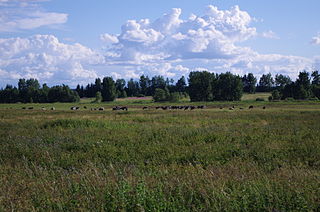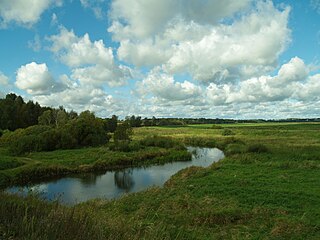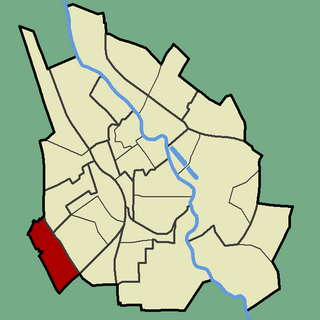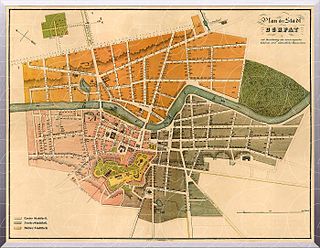
Tartu is the second largest city in Estonia after Tallinn. Tartu has a population of 97,435. It is 186 kilometres southeast of Tallinn and 245 kilometres northeast of Riga, Latvia. Tartu lies on the Emajõgi river, which connects the two largest lakes in Estonia, Lake Võrtsjärv and Lake Peipus. From the 13th century until the end of the 19th century, Tartu was known in most of the world by variants of its historical name Dorpat.

Tartu County is one of 15 counties of Estonia.

The Heino Eller Tartu Music College is a music school in Tartu, Estonia, founded in 1919. It got its current name in 1971, after the Estonian composer and music teacher Heino Eller, who taught in the school from 1920 until 1940.

Ülenurme Parish was a rural municipality in Tartu County, Estonia, directly south of Tartu.

The Ülikooli Street is a street in the center of Tartu in Estonia. Named after the University of Tartu whose main building is located on this street, it runs through the business district, passes behind the Town Hall building, and hosts a number of University-related facilities, including the university cafe, Von Bock House, the university book shop and the old Faculty of Chemistry building, which is also called the Marx Building. The Barclay Square, location of the Barclay de Tolli bust, and the Pirogov Square, location of the Nikolay Ivanovich Pirogov statue, are adjacent to the street.

Tartu Cathedral, earlier also known as Dorpat Cathedral, is a former Catholic church in Tartu (Dorpat), Estonia. The building is now an imposing ruin overlooking the lower town. In the small part of it that has been renovated is now located the museum of the University of Tartu, which the university also uses for major receptions.
Kaali-Liiva is a village in Saaremaa Parish, Saare County in western Estonia.

University of Tartu Botanical Garden, is a botanical garden in Tartu, Estonia. It belongs to the University of Tartu.

Annelinn is a neighbourhood of Tartu, Estonia, located on the left bank of Emajõgi River. It has a population of 27,755, or 27.34% of the whole city's population. With an area of 5.40 km2 (2.08 sq mi), it is also the largest. Annelinn mainly consists of 5 and 9-story Soviet apartment buildings. The project was made between 1969 and 1973 by Mart Port and Maie Meelak from "Eesti Projekt". It was originally planned to consist of four microdistricts but only two were finished. Annelinn is planned with the shape of amphitheater with ascending relief, and an imaginary centre located on the watermeadow of the Emajõgi River.

Raadi-Kruusamäe, or Raadi for short, is a neighbourhood of Tartu, Estonia. It has a population of 4,498 and an area of 2.83 km2 (1.09 sq mi). Raadi is mainly suburban area.

Ränilinn is a neighbourhood of Tartu, Estonia. It has a population of 1,674 and an area of 1.22 km2 (0.47 sq mi).

Supilinn is a neighbourhood of Tartu, Estonia. It is located just north of the city centre, on the right bank of Emajõgi River. Supilinn has a population of 1,863. With an area of 0.48 km2 (0.19 sq mi) it is the smallest neighbourhood of Tartu. Supilinn is especially famous for being a former slum, mostly consisting of 1–2 floored wooden apartment buildings.

Tähtvere is a neighbourhood of Tartu, Estonia. It has a population of 2,989 and an area of 2.50 km2 (0.97 sq mi).

Tammelinn is a neighbourhood of Tartu, Estonia. It has a population of 8,153 and an area of 3.11 km2 (1.20 sq mi).

Ülejõe is a neighbourhood of Tartu, Estonia. It has a population of 8,226 and an area of 3.02 km2 (1.17 sq mi).

Tartu Town Hall is the seat of the city government of Tartu, Estonia. It is located on Town hall square, in the city centre.

The Great fire of Tartu took place on 6 July [O.S. 25 June] 1775 and destroyed most of the city of Tartu in what is now Estonia. The fire destroyed the centre of the city.

Tartu Art Museum is a state-owned museum of art located in Tartu, Estonia. It was founded in 1940 on a private initiative by the members of local art school Pallas. This is the largest art museum in Southern Estonia.

Kissing Students is sculpture and fountain in Raekoja plats, Tartu, Estonia. The structure locates in front of Town Hall Square. The structure is one of the most recognised symbols of Tartu.

Lõunakeskus is a shopping and entertainment complex in Tartu, Estonia. It is the biggest shopping center in South Estonia. More than 170 shops and service providers operate in Lõunakeskus. The area of the center is 90,300 square meters, the center is visited annually by more than 5 million people.



















